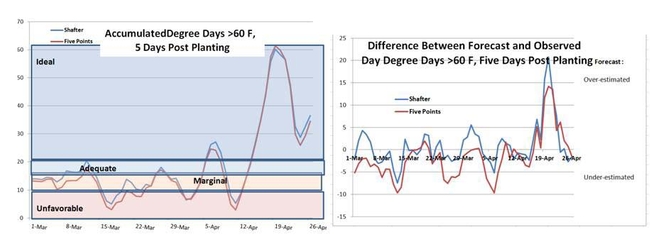- Author: Peter B Goodell
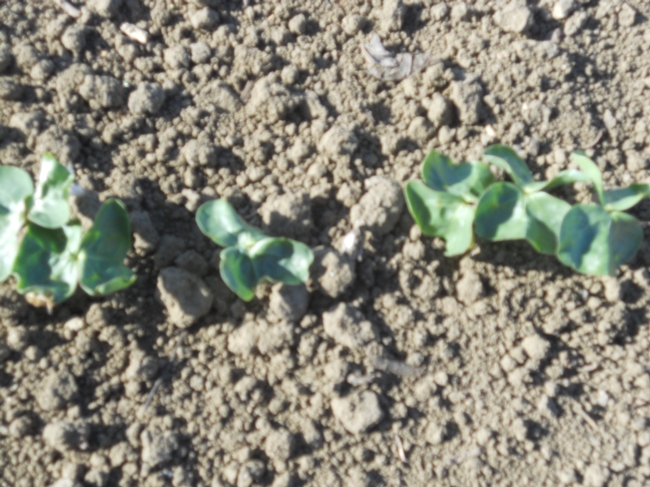
Cotton planting is well underway in the past 3 weeks now that the weather turned warm. While the initial planting was cool and intermittently wet, temperatures since April 16th in the San Joaquin Valley have been excellent for planting cotton. Looking at temperature conditions from March 1 to April 26, 2012 according to accumulated degree-days > 60◦ F five days after planting, Shafter and Five Points had 47% and 37% of those days in the Adequate to Ideal categories (Figure 1). 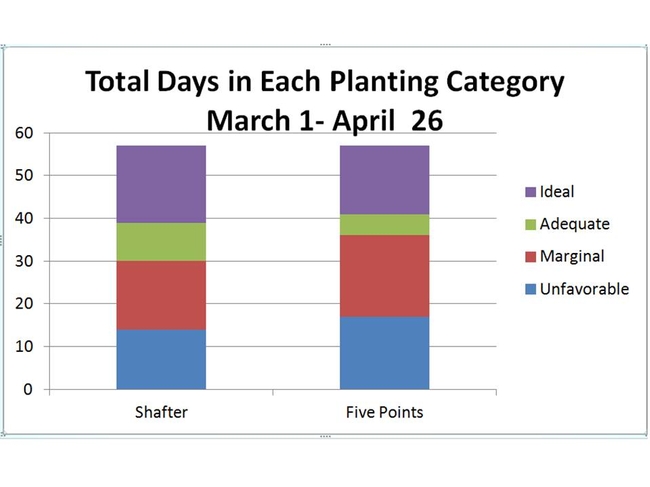
Since April 15th, all dates have had ideal heat accumulation five days after planting (Figure 2A). These data are based on actual temperatures rather than forecasted data. While the forecasted (predicted) degree day accumulation 5 days post planting varied from actual temperature recordings, this year it under-estimated the degree day total (e.g. more conservative) more than it over-estimated (Figure 2B). Some of the the difference can be attributed to inaccuracy in predicting temperatures five days out and the generalized nature of forecast as compared to actual site recording.
The cotton is germinating and emerging from the soil very nicely. In the warm days since April 15th, most cotton should have germinated 10-14 days after planting. Getting a good, vigorous stand is a fundamental step in developing a season long IPM plan. Assessing your stand to determine the number of plants/acre is a useful indicator to address replant concerns and future management decisions. Guidelines for assessing your stand can be found by clicking here on Cotton Year Round IPM site.
- Author: Peter B Goodell
Gathering in a cotton field near Mendota, CA, farmers, pest control advisers and UC Cooperative Extension gathered to discuss approaches to the challenges in cotto
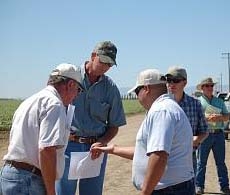
Three main factors for Lygus management need to be considered:
What is the source?
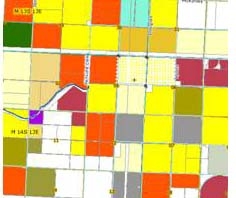
Is it a strong source such as safflower or seed alfalfa which produces large numbers of Lygus as the crop is prepared for harvest? Is it alfalfa hay which can mitigate the movement of the pest if habitat is preserved? Is it weaker sources like tomato or other poorer hosts which produce far fewer?
How far from the source is the field? The greater the distance from the source, the less the threat. Even the strongest sources have a limited sphere of influence, perhaps no greater than 2 miles.
How many Lygus are in the field and how much threat do they present?
It is essential to frequently monitor and record the cotton fruit retention as well as the population density of Lygus bugs. Both are critical for making the best decision. Small numbers of Lygus in a field with poor retention is a greater threat than a larger population in a well fruiting field. Remember the cotton integrates all stress, bugs or weather, and reflects that in current fruiting conditions See details in Field Check link below.
What to use to control Lygus?
Chose your material carefully to limit resistance pressure on the pest target. Understand IRAC mode of action labels and utilize rotation of active ingredients. Start with the most selective products to preserve your valuable inventory of natural enemies and avoid secondary outbreaks of aphids, mites or whiteflies. Move to more broad-spectrum insecticides later in the season. For a summary of UC IPM Guidelines for Lygus, see link below.
Group consenus
All ageed that the next four weeks is the critical period for setting fruit and establishing yield. They also noted that 2011 is only slightly behind 2010 which was a good year, yield-wise. Good management, including conscientious monitoring and decision making for Lygus can go a long way in setting up the remainder of the year.
Finally, most agreed that time spent checking your fields is an investment, not an expense.
FieldCheck June 2010
Lygus insecticide chart 6 11
- Author: Peter B Goodell
For over 20 years, UC has recommended plant based measurements as a basis for production decisions. These decisions include timing for Lygus treatments, using plant growth regulators, determining crop cutout and planning for defoliation. Details are
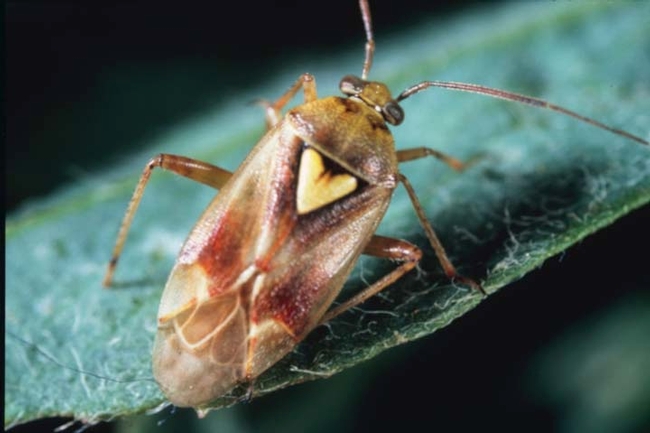
Why use plant based measures? Think of the plant like a patient in the physician’s office. Often questions that the doctor asks helps guide us toward a treatment. Likewise the cotton can tell a story, if you know how to read it. For Lygus management decisions, there are three key features; the age of the plant (number of fruiting branches), the early fruit (retention of fruit on the bottom five fruiting branches) and the current fruit load (retention of fruit on the top five fruiting branches).
The cotton plant cannot lie about previous stress it has suffered, including cool weather, early insect damage, poor irrigation timing or heat. Competition within the cotton plant for
resources is One stress we often ignore. Cotton produces more fruit than it can
mature because it produces fruit as insurance for its species survival. Thus,
as the season progresses, fruit is less likely to be retained under normal
yield loads. We know this because we measured it and can provide predictive
guidance about the probability of any fruit being maintained to harvest.
If you know the age of the plant, the current fruit load on the bottom and the current fruit load in top, you can determine whether your current retention is greater than expected (see table). If fruit was lost early, regardless of the cause, the current top fruit is more valuable and should be retained.
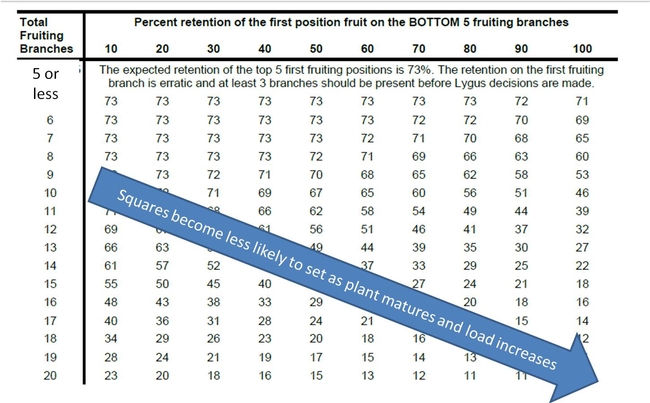
Letting the cotton plant tell its story is essential for setting treatment thresholds for Lygus. The threshold is dynamic depending on crop condition, age of the plant, time of year and surrounding sources for pests. Please go to cottoninfo.ucdavis.edu/IMAGES/FieldCheck_June_2011.pdf
and download, Using Plant Based Measurements to Support Lygus Management Decisions.
- Author: Peter B Goodell
Preventing Lygus bugs from coming into a cotton field is the next best thing to not having the pest at all. Since cotton is embedded in a complex cropping mosaic, bugs building in neighboring fields can move to cotton. While cotton is not a preferred crop for this insect to set up a household, it will, nonetheless, settle in if nothing else is available.
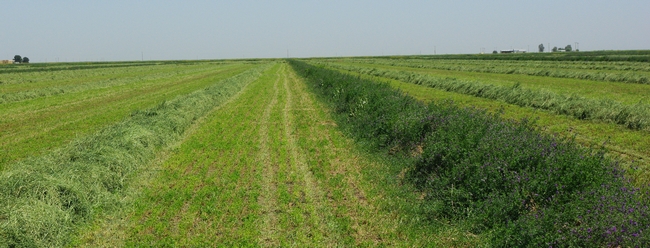
Since there is no indication from the plant that harvest is imminent, there is no urge to leave the alfalfa field. Our studies have shown Lygus will remain in a harvested alfalfa field for up to 24 hours before leaving.
However, if given a choice, such as an uncut strip of alfalfa, Lygus will stay longer in the alfalfa field and may not leave at all. Additional trials at Kearney Ag Center demonstrated that the population density within a strip can triple compared to density prior to harvest. In other words, they will stay on their familiar host as long it is available.
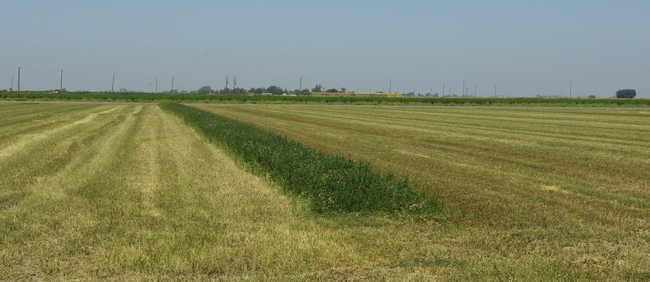
Throughout the San Joaquin Valley, alfalfa strips have become common and according to farmer testimonials, resulted in substantial savings in cotton treatment costs. These green islands provide a refuge for a reluctant pest and have been incorporated into the cotton IPM programs of thoughtful and progressive farmers.
For more information, see:
The IPM website page on managing Lygus in alfalfa
An impact statement on management of forage quality in strip-cut alfalfa
- Author: Peter B Goodell
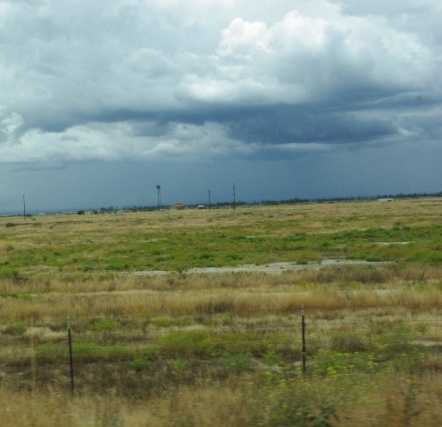
The large amount of rainfall this winter and spring will set the stage for more Lygus in summer. The relationship between historic rainfall records and annual cotton loss estimates supports the idea that Lygus will be more problematic this year and observations from the ground confirms this assessment. However, as in other years, the primary source of Lygus will be from crops and locations within a few miles of your cotton field, not miles away from the edge of the Valley.
In the past month, I have been conducting the annual Lygus survey. The survey was later than usual because of the extended rainy season into April and cooler temperatures in May. This is what I have observed:
- Foothills are generally dry and limited Lygus hosts, due primarily to early rains that favored grasses over broadleaves. 2011 was not a great year for wildflowers in the Sierra foothills due mostly because of the heavy grass prevented the annual broadleaves from developing widely.
- Along the I-5 corridor, tarweed, a key indicator host for Lygus, is located mostly south of Highway 198. It is more common on the valley flats than on the coastal foothills. When sampled 2 weeks ago, the population was split between overwintering adults and first generation nymphs, 1st to 3rd instars. The further south I travelled the more tarweed I could find in uncultivated areas of Kern County, commonly known as “deserts”. The importance of tarweed is not as much it is a major source for the Valley but rather as local infestation point and indicator of potential problems.
- Tarweed is a good plant for Lygus development because it spans the late winter and summer periods. It acts as a bridge for Lygus to develop a foothold and increase its numbers during May and parts of June. Without that bridge, populations tend to disperse and build slower and later.
Safflower plays a major role as a plant host bridge, allowing overwinter populations to settle and reproduce. Safflower plantings are spread throughout the Valley and will act as localized sources for Lygus into susceptible crops. The problem can be alleviated by managing Lygus population in safflower before the nymphs can become adults and leave the field. For details on managing Lygus in safflower to mitigate movement into cotton, refer to IPM in Cotton in the Western Region of the US, UC ANR Publication 3305.

